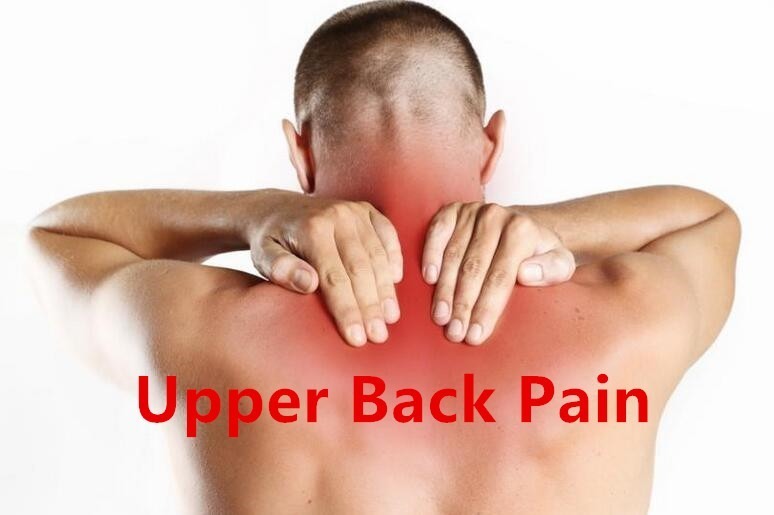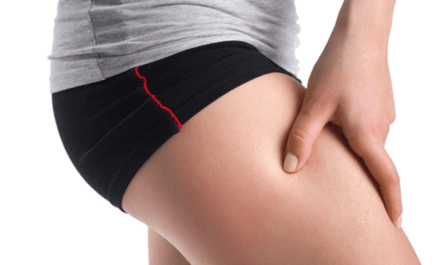The upper back, also known as the thoracic area, houses many important nerve clusters and muscle tissue. It connects the neck, shoulders, and arms with the rest of your body. Upper back pain can occur anywhere between the shoulder blades and the base of your neck. In addition, It can also cause weakness, numbness, or tingling in your arms or hands.
You’re likely to feel upper back pain after lifting something heavy or spending a lot of time in an awkward position with your arms raised. Arthritis, back strain from heavy lifting, or other strenuous activities can lead to severe mid or upper-back pain. This pain can sometimes be a symptom of more severe conditions, such as a herniated disc.
In many cases, this pain is temporary; however, it can also indicate a severe issue that needs to be addressed by a doctor. This article will discuss 12 common causes of upper back pain between shoulder blades with treatment.

Symptoms of Upper Back Pain Between Shoulder Blades
These symptoms can vary from person to person, but most sufferers will experience some combination of the following:
- Shooting or stabbing pain in the upper back and shoulders
- Pain or discomfort in the upper back when lifting or lowering arms above the head
- Trouble sleeping due to discomfort
- Fatigue or Nausea
- Tingling or numbness in arms
- Achy, heavy feeling in the upper back and shoulders
- Sharp or stabbing pain in the upper back when lifting or lowering arms above the head
- Pain or discomfort in the upper back when bending forward
- Pain or discomfort in the upper back when reclining
- Pain or discomfort in the upper back when coughing
- Pain in the upper back when lifting something from the ground
- Pain when holding something in your hands for a long time
- Sharp pain in the upper back and shoulders when reaching above your head
12 Common Causes of Upper Back Pain Between Shoulder Blades
1. Bad posture
Bad posture can lead to various health issues, including upper back pain. To prevent this issue, focus on maintaining good posture.
This doesn’t mean you must walk around with your chest puffed out all day. It would help if you lifted heavy things with good form; sleeping on a firm mattress to keep your spine in line are all ways to prevent pain from bad posture.
2. Pinched nerve
Pinched nerves can cause intense pain, numbness, tingling, or weakness in the arm, shoulder, and upper back. They usually happen when something pressing puts pressure on the nerve, like a muscle spasm, a bulging disc, or clothing.
The best way to avoid a pinched nerve is to treat any underlying cause, such as poor posture. Physical therapy and exercise can help reduce the likelihood of having a pinched nerve. Massaging the area and applying heat can also help ease the pain.
3. Osteoarthritis
Osteoarthritis is a degenerative condition with significant wear and tear on your joints, causing joint pain and stiffness.
It is common to experience pain in your upper back with this condition, especially when performing activities such as lifting heavy objects or leaning over to pick something up.
4. Herniated discs
Herniated discs are a common cause of neck and back pain in adults. Discs are the shock-absorbing cushions between the bones of your spine. They are made of a jelly-like material called disc fluid, which is essential for normal spine function.
Herniated discs happen when the disc fluid leaks out due to an injury or heavy lifting. This causes the disc to become skinny and stiff. The most common symptom of a herniated disc is constant back pain. The pain can range from mild to excruciating and often worsens with activity or bending over.
Herniated discs can happen to anyone at any age, but they are most common in people with a history of lifting heavy objects or poor posture.
5. Traumatic injury
A traumatic injury can cause upper back pain. This can include falls, car accidents, or sports injuries. Upper back pain can also be caused by a medical condition such as scoliosis.
Treatment for upper back pain will vary depending on the cause. In most cases, rest, ice, and medication help with pain relief. In some cases, physical therapy or surgery may be needed.
6. Arthritis
Arthritis is the degeneration of your joints and the surrounding tissues. There are many different types of arthritis, osteoarthritis, and rheumatoid.
If you suffer from osteoarthritis, rheumatoid arthritis, or another type of arthritis, you may experience upper back pain accompanied by stiffness, swelling, or tenderness in your joints and muscles.
7. Carpal tunnel syndrome
Carpal tunnel syndrome is a condition that causes tingling, numbness, and weakness in your hands, usually due to repetitive motion or heavy lifting. If you have this condition, you may also experience upper back pain.
8. Fibromyalgia
If you have fibromyalgia, you may experience upper back pain that worsens when you’re stressed or tired. You may also feel general fatigue, numbness, and tingling in your arms and hands.
9. Scoliosis
People with scoliosis often experience upper back pain and sideways curvature of the spine. As the condition progresses, you may also experience pain in your lower back.
10. Lung cancer
Pain on one side of your chest, a persistent cough, or trouble breathing are all signs of lung cancer. This type of cancer often spreads to the bones and can cause severe pain in the ribs and upper back. A lump in the chest is also a common symptom of lung cancer.
11. Tension and stress-related upper back pain between shoulder blades
You may experience tension in your upper back if you’re constantly stressed. This can lead to back pain, especially if you maintain this muscle tension for long periods.
If you struggle with tension in your upper back, consider taking time to relax and engage in activities like meditation, yoga, or tai chi that can help you reduce your stress levels.
You may consider seeing a therapist or counselor help you reduce stress and learn practical coping skills. You should also ensure you’re getting enough sleep and not staying up later than you need to.
12. Muscular strain from exercise and overwork
Engaging in strenuous activities, such as exercising too many hours a day, lifting excessive weight, or participating in sports, can strain your muscles. This can lead to upper back pain.
If you’re experiencing pain after exercising, you may need to scale back the time you spend exercising. You could also choose a less intensive activity that allows your muscles to recover between sessions.
You can also consider adding heat to your injury site. This will help relax your muscles, which may help reduce your pain. You could also take an ice pack to your upper back, which will help reduce inflammation.
Home Remedies For Upper Back Pain Between Shoulder Blades
Engage in gentle stretching and yoga poses – Yoga can help you reduce your stress levels and relax your muscles, which may help you manage your pain.
Use ice and heat – Applying ice to your upper back may help reduce your swelling and inflammation, while applying heat may relax your muscles.
Practice good posture – Use proper posture when sitting, standing, or walking. You should also avoid slouching, which may put more pressure on your upper back.
Get enough sleep – You should aim to get between seven and nine hours each night. Not getting enough sleep can increase your risk of injury and pain.
Take over-the-counter pain medications – You may want to talk to your doctor before taking them, but they can be helpful if you have moderate to severe pain while your upper back heals.
5 Best Stretches for Upper Back Pain Between Shoulder Blades
1. Arm Balance Row
This exercise can help to strengthen your upper back and improve your posture. It can also ease pain and stiffness in your upper back. You’ll need a resistance band to do this arm balance row exercise.
Loop it around the top of a door and grab the ends of the band in each hand. Stand in front of the door, and bend at the hips. Position your body at a 45-degree angle to the door.
Lift your elbows toward the ceiling to form a “W” shape with your arms. Bend your knees slightly and keep your spine straight, not curved. Slowly pull the band toward you, contracting your back muscles. Hold for a few seconds, and then slowly return to the start position. Repeat for 10 to 20 reps.
2. Pectoralis stretch
Try this pectoralis stretch to relieve pain and discomfort in your upper back. This exercise works the upper back muscles and helps ease tension in that area.
Stay seated in a chair with a straight back, and place one hand on your chest and the other on the back of your head. Gently push your chest forward while keeping your shoulders back. Hold the stretch for 20–30 seconds and switch hands.
This stretch will help increase the flexibility of the pectoralis muscles in your chest. You can also increase the stretch by placing a small weight (1–5 pounds) in your hands.
3. Thoracic extension
To relieve pain in your upper back, try this exercise daily. You can do it in bed before falling asleep, during your lunch break at work, or in the morning before starting your day.
First, lie on your back with your knees bent and your palms facing up. Focus on your breathing, and let your shoulders relax as much as possible.
Next, lift your chest as much as possible, keeping your chin tucked in. Hold this position for around 10 seconds, slowly lowering your body and exhaling as you do so.
4. Arm slide on the wall
Wall arm slides can be helpful for both upper and lower back pain. To do this exercise, stand about 3 feet from a wall and place your hands on the wall at chest level.
Sink your chest toward the wall as you slowly move your hands down the wall. Keep your elbows bent at a 90-degree angle and your shoulders relaxed as you slide your hands down the wall.
Hold this position for up to 1 minute. As you hold this position, focus on breathing deeply and slowly. This will help you relax and ease any tension in your upper back.
5. Wide Bent-Over Row
This exercise targets the muscles in your upper back responsible for lifting and moving heavy objects. It can also help reduce stress and tension in your body.
To do this exercise, stand with your feet shoulder-width apart and bend at your hips until your torso is about parallel with the floor. Next, lift one dumbbell in your left hand until it reaches chest level.
Exhale and slowly lower the dumbbell toward the floor until your arm is parallel. Inhale and slowly raise the dumbbell back to the starting position. Switch arms and repeat.
When should you see a doctor?
You should see a doctor if you experience back pain between shoulder blades that lasts more than a few days. This type of pain is rarely expected and could indicate a severe health issue, such as scoliosis or a herniated disc.
If your pain is accompanied by tingling or numbness in your arms, weakness, or a general loss of feeling below your waist, you should seek medical attention immediately. You should also visit the doctor if your pain is severe that it’s keeping you awake at night.
Conclusion
Upper back pain between shoulder blades is a common symptom experienced by many people, but it can also indicate more serious underlying issues. Understanding the causes and what to do about them can ensure you get the relief you need as quickly as possible.






